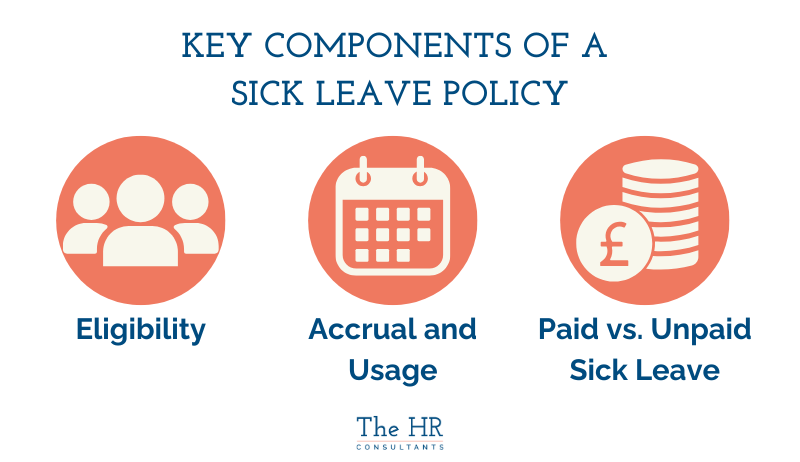"
A sick leave policy is a document that outlines the procedures and entitlements for employees who are unable to attend work, due to illness. It enables everyone to understand their rights and responsibilities, providing clarity for both employers and staff.
Managing sick leave effectively is essential for creating a harmonious and productive workplace. For an in-depth explanation, this guide from GOV.UK offers reliable information on paid statutory sick pay entitlements.
For employees, a fair policy provides reassurance during challenging times, knowing their health and well-being are valued. For employers, it breeds continuity, reduces operational disruptions, and supports compliance with employment laws.
This blog from The HR Consultants will walk you through everything you need to create or refine your sick leave policy, empowering your organisation to thrive while keeping your team supported and cared for.
Table of Contents
- Why Is a Sick Leave Policy Important?
- Key Components of a Sick Leave Policy
- Legal Considerations and Compliance
- Creating a Sick Leave Policy
- Communicating the Policy to Employees
- Sick Leave Policy Best Practices
- Final Thoughts
- Frequently Asked Questions
Why Is a Sick Leave Policy Important?
A clear and comprehensive sick leave policy isn’t just a legal necessity—it's the bedrock of people management. It provides structure, reduces misunderstandings, and increases trust between employees and employers. At its core, a sick leave policy is designed to provide support to employees when they’re unwell while maintaining operational stability for the business.
A well-crafted policy isn’t just about ticking legal boxes—it’s a tool to promote employee well-being and morale. It helps minimise disruptions by providing:
- A clear process for covering absences.
- Reduced uncertainty for managers and employees.
- Confidence that the business can adapt to short- or long-term absences effectively.
In the UK, employers must adhere to rules regarding statutory sick pay (SSP). You can find more information about SSP on GOV.UK.
Key Components of a Sick Leave Policy
Below, we break down the critical sick leave policy elements for you to include in your employment contracts.
Eligibility
Your policy should define who is eligible for sick leave. This may vary depending on employment status, such as full-time, part-time, or probationary employees. For instance:
- Full-time staff: Typically entitled to the full range of sick leave benefits.
- Part-time staff: Often entitled to pro-rata benefits.
- Probationary employees: May have limited entitlements, depending on company policy.
Aim for both fairness and transparency, which are crucial for maintaining employee confidence.
Accrual and Usage
How your employees earn and use sick leave is another key component. Some organisations offer a fixed annual allotment, while others use a rolling accrual system. You should also define:
- Whether unused leave carries over to the next year.
- The process for applying for sick leave, including notice periods.
Paid vs. Unpaid Sick Leave
Decide whether your policy includes paid sick leave, unpaid leave, or a combination of both. Many employers offer statutory sick pay (SSP) as a minimum, while others provide enhanced benefits. Whatever you decide, make sure your policy:
- Outlines support allowance terms.
- Complies with statutory requirements like SSP.

By addressing these components, you create a sick leave policy that is fair, transparent, and supportive, garnering trust and confidence among your team.
Legal Considerations and Compliance
When it comes to paid sick pay schemes and leave, you must understand how much sick pay employees are entitled to. In the UK, statutory sick pay (SSP) is the minimum legal requirement for employees who are ill for more than four consecutive days. Employers must pay eligible staff £109.40 per week (as of 2024) for up to 28 weeks, ensuring compliance with employment law.
It’s equally important to consider long-term or chronic illnesses. The Equality Act 2010 requires employers to make reasonable adjustments for employees with disabilities, including flexible working arrangements or additional leave. Ignoring these obligations can lead to legal consequences, as seen in cases where organisations fail to provide reasonable accommodations.
Remember: make sure your policy includes guidance on medical documentation, such as when employees should provide sick notes or other evidence of illness. This ensures fairness while protecting your business from potential misuse.
Creating a Sick Leave Policy
Drafting a policy starts with understanding your organisation’s unique needs. Begin by consulting HR experts or legal professionals to ensure compliance with relevant laws. Use clear, straightforward language that employees can easily understand.
For example, instead of writing, “Employees must submit documentation for absences exceeding statutory requirements,” say, “You’ll need an occupational health assessment from your doctor if you’re off for more than seven days.”
Here’s a step-by-step process to help you create an effective sick leave policy:
- Identify Your Organisation’s Needs Think about your workforce size, industry, and operational requirements. For example, a manufacturing company might need policies that account for shift-based work, while an office-based team might prioritise flexibility.
- Understand Legal Requirements Research the legal obligations in your country, such as statutory sick pay (SSP) in the UK or specific leave requirements for long-term illnesses. Consult resources like GOV.UK or employment law experts to stay compliant.
- Define Sick Leave Entitlements Specify who is eligible for sick leave (e.g., full-time, part-time, or probationary employees) and whether leave will be paid holiday, unpaid, or a mix of both. Be clear about how leave accrues and whether unused days roll over.
- Outline Notification Procedures Set clear expectations for how and when employees should report their absence. Include options like notifying their manager via email, phone, or an HR system.
- Detail Documentation Requirements Explain when employees need to provide a fit note or medical certificate, such as for absences longer than seven days.
- Consult Key Stakeholders Collaborate with HR professionals, managers, and employee representatives to ensure the policy meets the needs of everyone involved.
- Write and Review the Policy Use simple, clear language to draft the policy. Review it with legal and HR teams to ensure it’s accurate and compliant.
- Communicate the Policy Share the finalised policy with your employees through onboarding materials, team meetings, and digital platforms.
Your policy should also be flexible enough to adapt to different scenarios. Define clear steps for employees to follow, including how to notify their manager and submit documentation.
Communicating the Policy to Employees
Once your policy is finalised, make it accessible to your employees. Include it in onboarding materials, post it on your intranet, and share it in team meetings. A clear communication strategy ensures that everyone understands their entitlements and responsibilities.
For example, you could use a simple infographic to break down the process for requesting sick leave. Highlight steps like “Notify your manager → Provide a note if needed → Confirm your return date.” Using visuals and plain language can make the policy easier to remember and follow.
It’s also helpful to offer training for managers so they’re equipped to handle sick days and leave requests empathetically and consistently. A manager who understands the process can better support employees while maintaining fairness across the organisation.
A Cautionary Tale
Imagine a small marketing agency where the sick leave policy was vaguely worded and poorly communicated. Employees weren’t sure how to report absences or whether documentation was required. One team member began regularly calling in sick on Fridays without providing any medical evidence. Managers, unsure of the process, hesitated to address the pattern.
Over time, others noticed the lack of accountability and started taking similar liberties. Projects were delayed, team morale dipped, and trust between employees and management eroded. This scenario highlights how unclear communication can lead to policy abuse, operational disruption, and a breakdown in workplace harmony.
Managing Sick Leave Requests
Managing sick leave effectively requires a consistent process. Encourage employees to notify their manager as soon as they realise they’ll need time off. Whether this is done by email, phone, or an online system, make sure the process is simple and clear.
For absences longer than seven days, ensure employees know when to provide medical documentation. This protects both parties and prevents misunderstandings. Maintaining confidentiality is equally important—employees should feel confident that their personal health information will remain private.

If your organisation frequently deals with short-notice absences, consider establishing a backup plan for workloads. Cross-training team members can help ensure that tasks are covered when someone is unexpectedly off sick. This will reduce the stress of your team and maintain smooth operations.
Handling Abuse of Sick Leave
While most employees use sick leave appropriately, some may attempt to misuse it. Having clear policies in place can help prevent this. Specify in your policy that repeated absences without valid documentation will be investigated. Outline the steps for addressing potential misuse, such as informal discussions, formal warnings, or further disciplinary measures if necessary.
If you suspect misuse, start by having an open and honest conversation with the employee. In many cases, what appears to be abuse may actually be a sign of underlying issues like burnout, personal stress, or even workplace conflicts. By addressing these concerns empathetically, you can often find solutions that work for both the employee and the organisation, such as adjusting workloads or offering support. This approach resolves immediate issues, creating a culture of trust, accountability and fairness within your team.
Supporting Employees During Sick Leave
Supporting employees while they’re off sick is just as important as managing their return. Offering resources like Employee Assistance Programmes (EAPs) can provide employees with the help they need to address mental health concerns or navigate challenging personal situations.
This might include:
- Confidential Counselling Services One of the cornerstones of an EAP is access to confidential counselling. This can cover a range of issues associated with long term sickness, including stress, anxiety, depression, family problems, or workplace conflicts. Sessions may be offered in-person, over the phone, or online, providing flexibility for employees.
- Mental Health Support EAPs often include resources to help employees manage mental health challenges. This can range from therapy sessions to self-help tools like mindfulness apps and educational workshops focused on mental well-being.
- Legal and Financial Advice Many EAPs offer guidance on financial planning, debt management, or legal concerns. These services can help employees tackle external stressors that might otherwise impact their focus and performance.
- Work-Life Balance Resources Support in areas like childcare, elderly care, or relationship advice is another critical feature. Providing practical solutions for personal life challenges helps employees maintain a better balance.
- Crisis Management Support In times of emergencies, such as bereavement or traumatic incidents, EAPs often provide immediate assistance, ensuring employees have the support they need to cope effectively.
- Health and Wellness Initiatives Some programmes include fitness challenges, nutrition advice, and workshops on stress reduction to promote overall physical and emotional health.
For long-term absences, having a clear return-to-work plan can make the transition smoother. Discuss options like phased returns, reduced hours, or adjusted duties to accommodate the employee’s recovery. This approach demonstrates that you value their well-being and are willing to support them through their recovery.
Sick Leave Policy Best Practices
To keep your sick leave policy relevant and effective, review it regularly. Laws and workplace dynamics change, so staying up to date ensures compliance and fairness. Consider how your own sickness absence policy now aligns with broader workplace trends, such as the growing emphasis on mental health support.
Employee feedback is also invaluable. Regularly check in with your team to see if the policy is working as intended. You might discover areas for improvement, such as simplifying the sick leave application process or clarifying certain terms.
We've compiled a list of questions for you to ask yourselves while creating your sick policy:
- Is our policy legally compliant and up to date?
- Does our policy address both short-term and long-term absences?
- Is the policy clear and accessible to all employees?
- Are managers properly trained to handle sick leave requests?
- Does our policy encourage employee well-being?
The Role of Technology in Managing Sick Leave
Technology can streamline the management of sick leave. HR software, such as BrightHR, allows you to track absences, automate approvals, and analyse trends. Some systems let employees submit fit notes digitally, saving time for both staff and managers.

Analytics tools can also provide insights into absenteeism patterns, helping you identify potential issues before they escalate. For instance, if your data shows a spike in absences during busy periods, it may indicate workplace stress. By addressing these trends proactively, you can improve employee satisfaction and reduce future absences.
Final Thoughts
A well-designed sick leave policy is more than a legal requirement—it’s a vital part of cultivating a supportive and productive workplace. By prioritising clarity, fairness, and employee well-being, you create a framework that benefits everyone.
Take the time to review or refine your policy and talk to us. It’s an investment in your organisation’s success and your team’s trust.
[addCTA blink=""/services/hr-documentation/"" title=""Get HR advice on how to document your sick leave policy""]
Frequently Asked Questions
Here are some frequently asked questions about sick leave policy.
What is the difference between statutory sick leave and company sick leave?
Statutory sick leave provides the legal minimum entitlements, such as Statutory Sick Pay (SSP), which ensures basic financial support during illness. Company sick leave policies may offer enhanced benefits, such as full pay for a certain number of days or additional allowances.
How should employers handle sick leave during a probationary period?
Employers should clearly outline sick leave entitlements in their policies. While many companies limit benefits during the probation period, transparency and clear communication ensure employees understand their rights.
Can employees use sick leave to care for a family member?
Sick leave is generally intended for personal illness. To care for a family member, employees may need to request other leave types, such as compassionate leave or emergency leave, if supported by company policies."












